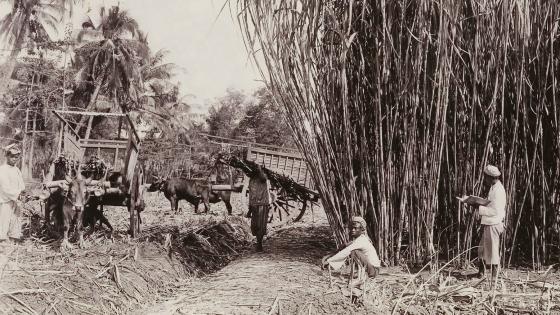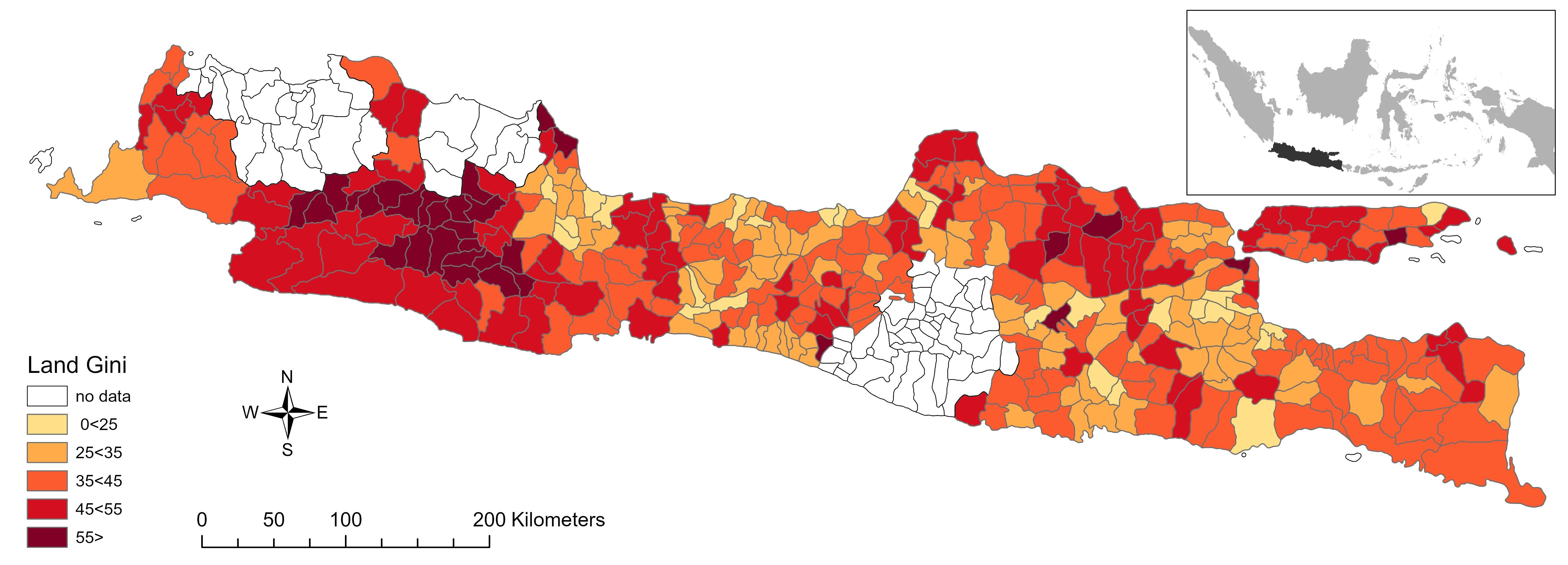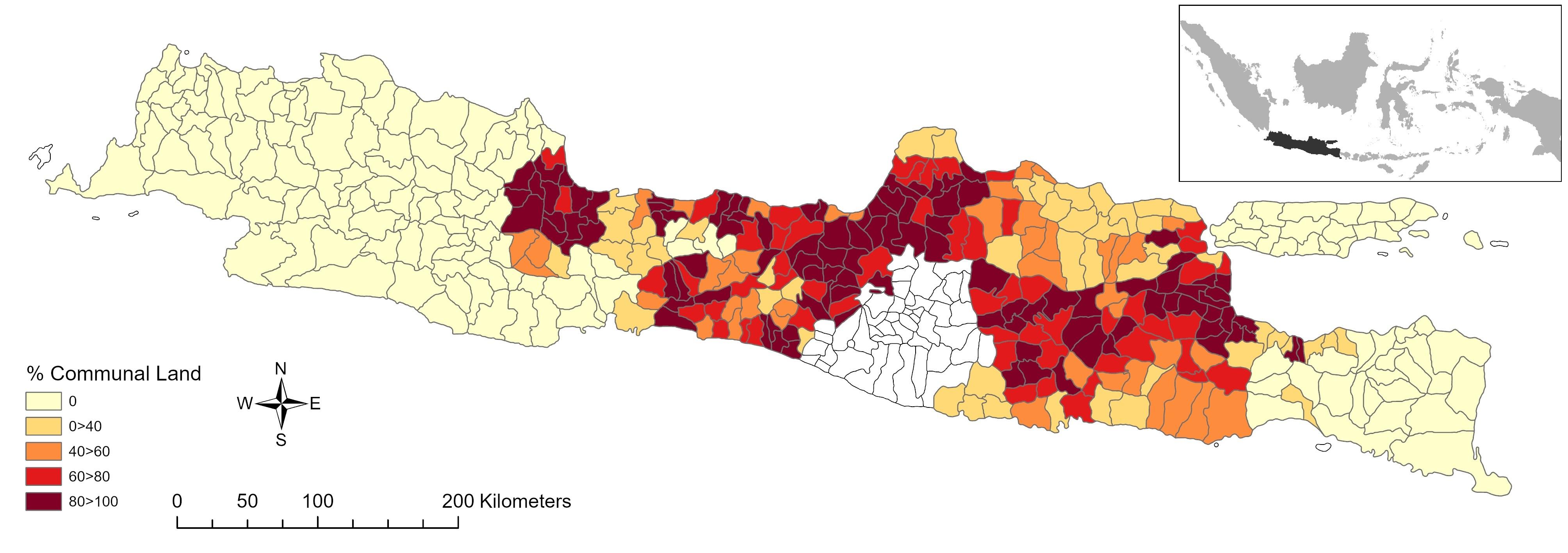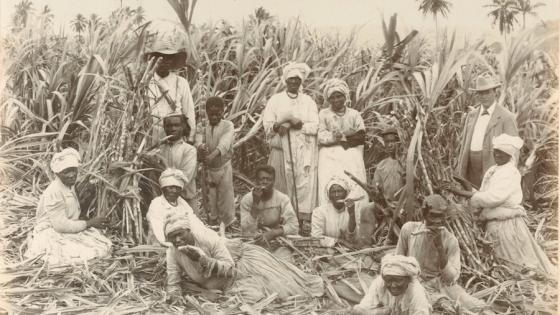Land represents the primary source of income and wealth in many agricultural economies. Land inequality is negatively correlated with long-run economic growth (Deininger and Squire 1998) and associated with political and social inequality (Frankema 2010). Moreover, because land is often transferred from one generation to the next, land inequality tends to persist over time. It is therefore crucial to understand the factors that influence land distribution in both the past and present. Colonial institutions, property rights regimes, and cash-crop production have been regarded as major factors driving land inequality in former colonies (Acemoglu and Robinson 2017, Banerjee and Iyer 2005, Glaeser et al. 2020, Panza et al. 2017). In De Zwart and Soekhradj (2023), we analyse how sugar cultivation and colonial institutions influenced property rights and land distribution across 368 districts in colonial Java, Indonesia, around the turn of the 20th century.
While earlier studies argued that extractive institutions and colonial cash-crop production like sugar cultivation were associated with high levels of inequality, more recent contributions have emphasised the context-specific nature of this relationship (Bruhn and Gallego 2012, de Zwart 2022). We examine extensive district-level data from colonial reports, alongside mid-19th and early 20th-century investigations into the living conditions of the Javanese, and find that this was also the case in colonial Java. In fact, we demonstrate that colonial sugar cultivation in the late 19th century (Figure 1) led to lower inequality among landholders as measured by the land Gini in 1903 (Figure 2). This is confirmed by the qualitative observations of colonial investigators in the mid-19th century, who observed a major sugar region in eastern Java. Prior to the implementation of colonial sugar cultivation, they concluded, “there was an unequal distribution of farmland, and the burdens on the peasants were unevenly shared, against the current situation of evenly distributed lands and burdens”.
Moreover, we questioned whether the relationship between sugar cultivation and land distribution was causal by using an instrumental variables approach and relying on the exogenous variation in geographic and climatic conditions that are optimal to growing sugar. We calculated a land Gini that includes the landless population in a district and showed that the relationship with sugar cultivation was also consistently negative, but not statistically significant. The reduced strength of this relationship likely results from the fact that districts with more sugar cultivation also drew more migrants from the late 19th century on, which increased the landless population in a district.
Figure 1 Share of land used in sugar cultivation, 1892/95
Source: De Zwart and Soekhradj (2023, Figure 4).
Figure 2 Land inequality among landholders, 1903
Source: De Zwart and Soekhradj (2023, Figure 1)
What explains this counterintuitive result? We suggest that the effect of colonial sugar cultivation was crucially mitigated by property rights to land. Three types of property rights to land prevailed in colonial Java:
- Land held under private and heritable tenure, which could generally be subdivided into smaller plots, bought and sold.
- Land held under communal tenure with fixed shares. In this case, land was under ownership of the village, but a peasant would cultivate the same plot of land each year, and rights to the plot would be transferred from father to son. The main difference between this system and private tenures was that this land could not be bought or sold without permission of village authorities.
- Communal lands that were periodically distributed so that each peasant would cultivate a different plot each year.
In all three cases, in return for the right to work the land, peasants had to perform labour duties for the colonial government.
Colonial sugar cultivation stimulated both types of communal landholding (numbers 2 and 3, above) during the period of the Cultivation System (1830 to 1870), when sugar production was a government monopoly, as well as in the period of liberalisation that followed. First, in the Cultivation System, Javanese peasants were forced to devote a substantial share of their land and labour to the production of various cash crops, of which sugar and coffee were the most important (De Zwart et al. 2022). Java in the early 19th century was labour scarce, while sugar cultivation was particularly labour intensive. Labour duties were levied only on those peasants who had access to land, creating an incentive to distribute lands widely throughout the population, both for the colonial government (to increase the available pool of labour) and for the local peasantry (to decrease the individual forced-labour burden).
Second, in the period between 1870 and 1900, land became the scarce factor of production, and the Cultivation System was gradually abolished. As some communal land was periodically redistributed, and since sugar production exhausted the soil more than rice cultivation, the colonial sugar industry benefitted from periodic redistribution of plots, which allowed consistent access to replenished soils. All the more so because the sugar industry could exploit the power of village heads to allocate the best fields to them each year. The colonial sugar industry’s need for labour and fertile soils thus stimulated the extent of communal tenure (with and without annual redistribution of lands). Communal systems of land tenure consequently led to more equally distributed plots, as they limited the process that leaves land accumulation in the hands of the few.
Quantitative analyses using district-level data suggest that there was indeed a strong and highly robust relationship between sugar cultivation and the share of land held under communal tenure with both fixed and rotating shares (Figure 3). Again, the statistics are backed up by qualitative evidence, as mid-19th-century colonial investigators found that “sugar cultivation caused changes in the rights and duties of the population [...] as it became clear from the information received that prior to the implementation of sugar cultivation lands here were partially under individual tenure, whereas now the system of communal land is dominant”.
Figure 3 Share of land under communal tenure, 1895
Source: De Zwart and Soekhradj (2023, Figure 5)
Thus, while it has been observed in some of the literature that the production of cash crops which benefit from economies of scale, such as sugar, tend to increase inequality, this was not the case in colonial Java. Sugar cultivation stimulated the expansion and persistence of communal landholding, which led to more equally distributed plots among landholders in the early 20th century. We emphasise the importance of local property-rights institutions in mitigating the effects of export production on socioeconomic outcomes.
References
Acemoglu, D and J A Robinson (2017), “The economic impact of colonialism”, VoxEU.org, 30 January.
Banerjee, A and L Iyer (2005), “History, Institutions, and Economic Performance: The Legacy of Colonial Land Tenure Systems in India”, American Economic Review 95 (4): 1190–1213.
Bruhn, M and F A Gallego (2012), “Good, Bad and Ugaly Colonial Activities: Do They Matter for Economic Development?”, Review of Economics and Statistics 94 (2): 433–61
Deininger, K and L Squire (1998), “New Ways of Looking at Old Issues: Inequality and Growth”, Journal of Development Economics 57 (2): 259–87.
Frankema, E (2010), “The Colonial Roots of Land Inequality: Geography, Factor Endowments, or Institutions?”, Economic History Review 63 (2): 418–51.
Glaeser, E, A Schleifer and S Djankov (2020), “Measuring property rights institutions”, VoxEU.org, 25 September.
Panza, L, J G Williamson and T Burnard (2017), “Sugar and slaves: Wealth, poverty, and inequality in colonial Jamaica”, VoxEU.org, 6 December.
de Zwart, P (2022), “Indonesian Inequality in the Late Colonial Era: New Evidence on Regional Differences”, Cliometrica 16 (1): 175–211.
de Zwart, P, D Gallardo-Albarrán and A Rijpma (2022), “Demographic effects of colonialism: Forced labour and mortality in nineteenth-century Java”, VoxEU.org, 4 April.
de Zwart, P and P Soekhradj (2023), “Sweet equality, property rights and land distribution in colonial Java”, Explorations in Economic History (see also CEPR Discussion Paper DP17278).






